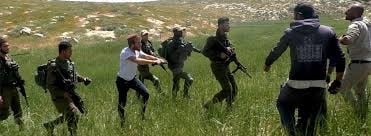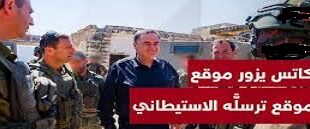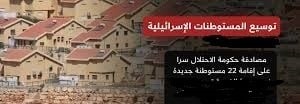By: Madeeha Al-A’raj
The National Bureau for Defending Land and Resisting Settlements stated in its latest weekly report , that on 23rd of this month, Sept 2024, the Israeli Minister of Interior, Moshe Arbel and other ministers called for the expansion of settlements in the occupied West Bank, in clear harmony with the Israeli War Government, led by the Netanyahu, Smotrich and Ben Gvir, defying the international laws. Arbel said in statements in the Gush Etzion settlement near Bethlehem, “Now, specifically, when we are dealing with security challenges, we must work more forcefully for the benefit of the settlements in the West Bank and to strengthen, develop and deepen the roots in them.”
Ariel doesn’t belong to the ‘Religious Zionism Party’ or the ‘Jewish Power Party’, but to the Torah-Conservative Eastern Jews Party’ also known as the ‘Shas Party’, led by Aryeh Deri. It was founded in 1984 by the Jewish religious leader Rabbi Ovadia Yosef in response to the discrimination felt by the religious segment of the Eastern Jews ‘Sephardim’ since the establishment of Israel in 1948, at the hands of the Western Jewish elite ‘Ashkenazim’, who along with the Labor Party ‘Mapai’, monopolized power and positions of influence in Israel for many years.
His call came as an extension of the policy of the Israeli war government, which was formed at the end of 2022 following the last Knesset elections and declared settlement a ‘national value’ and has so far approved more than 80 settlement plans in all the governorates of the West Bank, including occupied East Jerusalem, and tens of thousands of settlement units, and has expanded in an unprecedented manner in seizing Palestinian lands through government decisions or military orders that have transformed vast areas into ‘state lands’, in preparation for transforming them into a vital area for settlement activities, and has legalized dozens of settlement outposts and the so-called pastoral farms.
Noting that the ‘Shas Party’ supports settlement, and has its supporters among the settlers in the Haredi settlements, but it is not as extreme as the Religious Zionists, the Jewish Power, or even the Likud in this regard. For example, it didn’t participate in the ‘Gaza Settlement Festival’ that was held in Jerusalem last January. However, the fact that some of its leaders joined the Likud, the Zionist Power, and the Jewish Power parties provides a striking indication when expansionist settlement ambitions are linked to imaginary or alleged security pretexts.
Thus, a new ally joins the ongoing transformations in Israeli society, calling under the guise of security to expand settlement activities based on the plan that Smotrich is implementing after he tightened his control over the Civil Administration, which works on multiple levels to impose more facts on the ground in the context of annexing lands classified according to the agreements signed between the Palestinian and Israeli sides as Area C, and gradually imposing Israeli sovereignty over them and raising the number of settlers to 1,000,000 during 2 decades, by bypassing the arrangements that were in place in the Civil Administration before the coup led by Smotrich, who announced last August a fundamental change in the legal infrastructure and a change in what he called the DNA of the system of work in this administration, and transferring this system from a military occupation system that has obligations toward the population under occupation according to international law to a system in which Israeli civilian government institutions manage aspects of Palestinian life in the West Bank in which civilian ministries assume the task that was previously undertaken by the Israeli Central Military Command, based on the government’s guiding principles, the essence of which is that “the Jewish people alone have an exclusive right to indisputably throughout the land of Israel i.e. ‘Palestine’ by strengthening and developing settlement throughout the land of the ‘Galilee, the Negev, the Golan Heights, Judea and Samaria’.
The principles on the basis of which Smotrich established a separate civil system in the Civil Administration under his management and appointed a settlement administration similar to a government ministry, headed by his close associates such as Yehuda Eliyahu, Smotrich’s partner in founding the ‘Regavim settlement organization’, and appointed Hillel Roth as deputy head of the Civil Administration with broad powers in the Ministry of Armu. As known, Roth is a member of the ‘Od Yosef Shai School’ led by the settlers and a resident of the Revava settlement, he served as the financial and administrative director of the ‘Honenu’ organization, a group providing legal assistance to right-wing movements, and later as treasurer of the Shomron Regional Settlement Council.
Within the context, with the first days of the brutal war waged by the occupying state on the Gaza Strip, the Israeli occupation army imposed, under flimsy security pretexts, buffer zones around many settlements in various governorates of the West Bank. This resulted in preventing Palestinians from reaching their lands. The buffer zones start from a point no more than 200 meters from built-up areas, as is the case with the villages of Qaryut, As-Sawiya, Al-Lubban Ash-Sharqiya, Jalud, Qasra, and Duma in the Nablus Governorate, and Turmusaia and Sinjil in the Ramallah Governorate, to name a few, under the pretext of providing security for the settlements of Eli, Shilo, Rachel, Ma’ale Lafuna, and the surrounding settlement outposts that are spreading like mushrooms around those settlements.
Under various circumstances, the buffer zones are a convenient way for settlers to expand and seize large areas of land and turn them into a vital area for the expansion of terrorist settlement outposts and so-called pastoral farms. In special circumstances, they are a way to prevent farmers from reaching their lands and fields, especially the olive groves that extend into the mountains, hills and plains of the targeted Palestinian villages. In Qariout, the buffer zones surround the village from the west, east, and south, leaving it only a narrow area in the north as a side for movement. The same applies to the village of Burqa, north of the city of Nablus, which was besieged by the occupation measures and imposed a tight security belt on it under the pretext of providing security for the Homesh settlement outpost, which resulted in depriving the villagers of access to hundreds of dunams around the village.
Last year’s olive harvest season was difficult for Palestinian farmers in the West Bank due to the restrictions imposed on their movement by the buffer zones established by the occupation around the settlements and the violence of both the occupation soldiers and settler gangs against them. Citizens were unable to access an area estimated by OCHA to be about 96,000 dunams planted with olive trees in various governorates of the West Bank, whether they located behind the apartheid wall or those located around the settlements, especially in light of the impossibility of obtaining what is called ‘prior coordination’, after the Israeli authorities cancelled almost all of these approvals, effectively preventing farmers from accessing their lands.
The agricultural gates along the wall erected around the West Bank remained largely closed, which caused farmers losses estimated at the time at about 1,200 metric tons of olive oil during the season, which led to a direct economic setback amounting to tens of millions of shekels, especially in the northern Governorates of Tulkarm, Qalqilya and Nablus, with a particularly severe impact. In the village of Turmusaya, for example, more than 180 Palestinian farmers were unable to access their lands located near the Shilo settlement and its outposts during the mentioned season, covering an area estimated at 2,500 dunams, including 1,000 dunams in areas that usually require prior military approval to access, in addition to 1,500 dunams in other parts of Areas C and B.
In parallel with the security buffer zones and other measures taken by the occupation authorities to restrict Palestinian citizens and besiege them in pockets surrounded by settlements, the authorities have started bulldozing large areas of citizens’ lands in further siege. The bulldozing operations continue in an uninterrupted series in various areas. Settlers bulldozed a mountainous land planted with olives and another flat land estimated at about 15 dunums in the ‘Khirbet Sarra area’ southeast of the Qariot village in the Nablus Governorate, in an area located between the ‘Shovot Rachel and Shilo settlements’, and more than 20 dunums in the Beit Ula town, west of Hebron, in the “Zamzum and Atuf” areas located west of the town, in addition to uprooting hundreds of olive trees, and areas of land in the Qarawat Bani Hassan town in the Salfeet Governorate in the Bir Abu Ammar area northwest of the ton. The Israeli occupation authorities also announced the seizure of 8 dunums of citizens’ land in the Fasayil village in the Jericho and Jordan Valley Governorate, pursuant to a military order, with the aim of adding a section of a new security road linking the ‘Tomer settlement’ south of Fasayil in the Jericho Governorate to Road n. 90.
The greatest suffering was in the Um Safa village in the Ramallah and Al-Bireh Governorate, where the citizens live under a stifling and permanent siege, and large areas of their lands are exposed to bulldozing. The village is surrounded from all sides, with the Ateret settlement in the east, Halamish in the west, and a bypass road in the south, bulldozing its lands from the north. The area targeted for bulldozing is 500 dunams, and work is underway to transform it into a vital area for settlement outposts that are expanding north of the village and destroying farms, fields and retaining walls in an area that the occupation authorities claim is ‘state land’, even though its owners have official papers dating back to before the occupation of the West Bank in 1967.
On another level, in his briefing before a session held by the UN Security Council on the 19th of this month, regarding the implementation of resolution 2334 of 2016, the Special Coordinator for the Middle East Peace Process, Tor Wennesland, said that ‘settlement activity and the devastating conflict in Gaza continue, alongside daily violence in the occupied West Bank, despite the call of Security Council Resolution 2334 for an immediate and complete cessation of all settlement activities, and taking immediate steps to prevent all acts of violence against civilians.
He stressed that settlement expansion, settler violence, recent Israeli administrative steps, and large-scale declarations of government land in the occupied West Bank fundamentally change the landscape and further deepen the occupation, and that the demolition and confiscation of Palestinian-owned buildings entails numerous human rights violations and raises concerns about the risk of forcible transfer.
Resolution 2334, issued by the UN Security Council on Dec. 23, 2016, affirmed that Israel’s establishment of settlements in the Palestinian territory occupied since 1967, including East Jerusalem, has no legal validity and constitutes a flagrant violation under international law and a major obstacle to the achievement of the two-state solution and the establishment of a just, lasting and comprehensive peace.
He reiterated its demand that Israel immediately and completely cease all settlement activities in the occupied Palestinian territory, including East Jerusalem, and fully respect all its legal obligations in this regard. It is well known that the occupying state’s government had approved this year the confiscation of 2,600 dunams last Feb., 8,000 dunams in March, and about 12,700 dunams in late June in the Jordan Valley, which is the largest confiscation of Palestinian land in the occupied West Bank in 30 years, despite international condemnations and warnings.
List of Israeli Assaults over the Last Week Documented by the National Bureau:
Jerusalem:
- Laying the foundations for building an electric elevator 200m from the Buraq Wall towards Al-Aqsa Mosque. to facilitate the storming of Al-Aqsa by disabled and elderly settlers, according to the occupation’s allegations.
Hebron:
- Attacking Palestinian people in the old city of Hebron, and threw stones at them, destroying a number of their properties and damaging the doors of shops.
- Assaulting citizen, Hafez Bilal Al-Arini while he was grazing his sheep in the ‘Al-Harun area’ in the Tutanah village in Masafer Yatta, and tried to steal his sheep.
- Attacking citizens’ homes in the ‘Harebat Al-Nabi area’ and stole a large number of sheep belonging to citizens Ali Sabah and Abdul Mohsen Rashid, after detaining their families and forcing them to gather in one room. They searched the homes and sheep pens and caused them severe damage. Citizen Abdul Karim Al-Jabari said that the settlers attacked citizens’ homes in the “Ja’bara” area east of the city, where the extremist minister Itamar Ben Gvir lives, and his home is only a few meters away from the homes that were attacked.
- Demolishing the house of citizen Moataz Abu Jaheisha in Wadi Rasha, in the Idhna town, a water well with a capacity of 80 cubic meters, and the house of citizen Misbah Abu Zalta, which is under construction, located in ‘Khallet Sa’d area’, under the pretext of building without a license, and a number of agricultural rooms, one of which belongs to citizen Abdul Halim Faraj Allah, in the ‘Wadi Al-Bir area’ to the west of the town.
- Attacking shepherds and citizens in Khirbet Zanouta, expelled them from their lands, prevented them from approaching their wells and watering their livestock, and tampered with their drinking water and poured it on the ground.
- Bulldozing more than 20 dunams, uprooted more than 600 fruit trees, and demolished a number of agricultural facilities and wells in the areas of ‘Zamzum and Atuf’ located west of the Beit Ula town.
Bethlehem:
- Setting up a military checkpoint in the Al-Walaja village, northwest of Bethlehem, in front of Ein Al-Haniya, west of the village of Al-Walaja, to serve settlement ambitions and control water sources in the area. This will prevent citizens from reaching their lands and seize more lands surrounding Ein Al-Haniya, the area, estimated at about 250 dunams.
Ramallah:
- Assaulting citizen Rizq Abu Naim, 60, while he was in his home in the ‘Al-Khalayel area’ near the ‘Ein Al-Banat area’ in the Al-Mughayir village, east of Ramallah, insulted him and forced him and his family to leave their home at gunpoint.
- Demolishing agricultural facilities in the Beit Sira village, west of Ramallah, and a small café under the pretext of building without a license.
Nablus:
- Attacking citizens in Khirbet Tana, east of Nablus, and prevented them from reaching the water spring, and expelled them from the area under the protection of the occupation forces.
- Bulldozing a mountainous land planted with olives, and another flat land estimated at 15 dunams in Khirbet ‘Sara’, southeast of Qariot. The targeted area is located between the settlements of ‘Shovot Rachel and Shilo’, which were built on the village lands, which are subject to constant raids by settlers.
Salfeet:
- Attacking citizens’ vehicles at the entrance to the village of Yasuf, east of the city, and threw stones at them, causing damage to a number of them.
- Bulldozing areas of the Qaraweh Bani Hassan town in the Bir Abu Ammar area.
- Torching a shepherds’ tent in the village of Rafat, belonging to citizens Mufid and Yasser Qassem Ayash, and completely destroyed the site.
Jenin:
- Demolishing a house belonging to the citizen Younis Zaid, with an area of about 120m2, under the pretext of building without a license in the village of Tura al-Sharqiya, southwest of Jenin.
Jordan Valley:
- Storming the Arab Al-Malihat Gathering, until they reached the Arab Al-Ka’abneh Elementary School.
- Provoking people in the Al-Jiftlik village.
- Attacking shepherds and assaulted citizen Kinan Rafeh Fuqaha in the Hamma area in the northern Jordan Valley. Seizing 8 dunums of citizens’ land in the Fasayil village, pursuant to a military order aimed at adding a section of a new security road linking the ‘Tomer settlement’ to Road n. 90.
- Demolishing a house with an area of 100m2, belonging to Khalil Radi Khalil Zawahra, in addition to destroying facilities and property belonging to the house, including a water tank and solar panels in the Burj area, and a house under construction, belonging to Hamed Jaber in the Aqaba village, east of the city of Tubas.
 المكتب الوطني للدفاع عن الارض ومقاومة الاستيطان منظمة التحرير الفلسطينية
المكتب الوطني للدفاع عن الارض ومقاومة الاستيطان منظمة التحرير الفلسطينية




